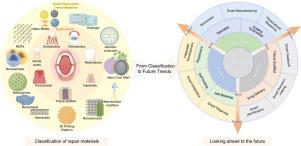牙科修复中的智能生物材料:最新进展和未来展望
IF 10.2
1区 医学
Q1 ENGINEERING, BIOMEDICAL
引用次数: 0
摘要
修复牙科中的智能生物材料设计用于检测和响应各种生理和环境刺激,包括机械应力,pH值波动,温度变化以及磁场或电场。与传统的惰性修复材料不同,这些智能系统将诊断和治疗功能集成到临床实践中。本综述系统地总结了智能修复材料的最新进展,采用了一种结合文献分类和比较评价的方法。这些材料分为纳米复合材料、水凝胶、生物活性剂、化学和树脂基系统、智能载体平台和陶瓷基材料。对于每个类别,我们检查了设计策略、潜在机制和具有代表性的实验或临床前研究结果。该分析强调了药物递送、抗菌-再矿化耦合、自修复能力和组织工程应用方面的进展。此外,综述概述了每种材料类别的优点和局限性,评估了它们的临床转化准备情况,并确定了广泛采用的技术障碍。最后,展望了未来的研究方向,包括多刺激耦合、仿生功能化以及与数字牙科技术的集成。总之,这篇综述提供了一个全面的方法和智能修复材料的发展前景,以支持其从实验室创新到临床应用的转化。本文章由计算机程序翻译,如有差异,请以英文原文为准。

Smart biomaterials in restorative dentistry: Recent advances and future perspectives
Smart biomaterials in restorative dentistry are engineered to detect and respond to diverse physiological and environmental stimuli, including mechanical stress, pH fluctuations, temperature changes, and magnetic or electrical fields. Unlike conventional inert restorative materials, these intelligent systems integrate both diagnostic and therapeutic functions into clinical practice. This review systematically summarizes recent advances in smart restorative materials using a methodology that combines literature-based classification with comparative evaluation. The materials are categorized into nanocomposites, hydrogels, bioactive agents, chemical and resin-based systems, intelligent carrier platforms, and ceramic-based materials. For each category, we examine design strategies, underlying mechanisms, and representative experimental or preclinical findings. The analysis highlights progress in drug delivery, antibacterial–remineralization coupling, self-healing capacity, and tissue engineering applications. In addition, the review outlines the advantages and limitations of each material class, evaluates their readiness for clinical translation, and identifies technical barriers to widespread adoption. Finally, future research directions are discussed, including multi-stimulus coupling, bioinspired functionalization, and integration with digital dentistry technologies. Overall, this review provides a comprehensive methodological and developmental perspective on smart restorative materials, with the goal of supporting their translation from laboratory innovation to clinical application.
求助全文
通过发布文献求助,成功后即可免费获取论文全文。
去求助
来源期刊

Materials Today Bio
Multiple-
CiteScore
8.30
自引率
4.90%
发文量
303
审稿时长
30 days
期刊介绍:
Materials Today Bio is a multidisciplinary journal that specializes in the intersection between biology and materials science, chemistry, physics, engineering, and medicine. It covers various aspects such as the design and assembly of new structures, their interaction with biological systems, functionalization, bioimaging, therapies, and diagnostics in healthcare. The journal aims to showcase the most significant advancements and discoveries in this field. As part of the Materials Today family, Materials Today Bio provides rigorous peer review, quick decision-making, and high visibility for authors. It is indexed in Scopus, PubMed Central, Emerging Sources, Citation Index (ESCI), and Directory of Open Access Journals (DOAJ).
 求助内容:
求助内容: 应助结果提醒方式:
应助结果提醒方式:


